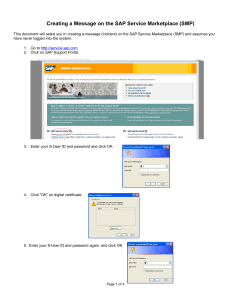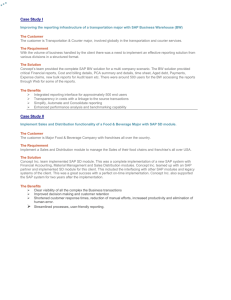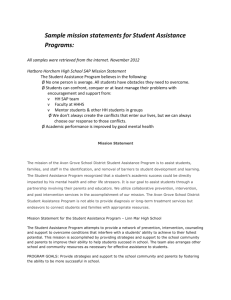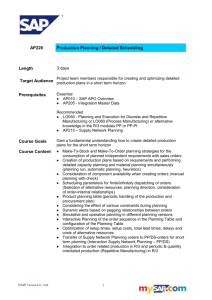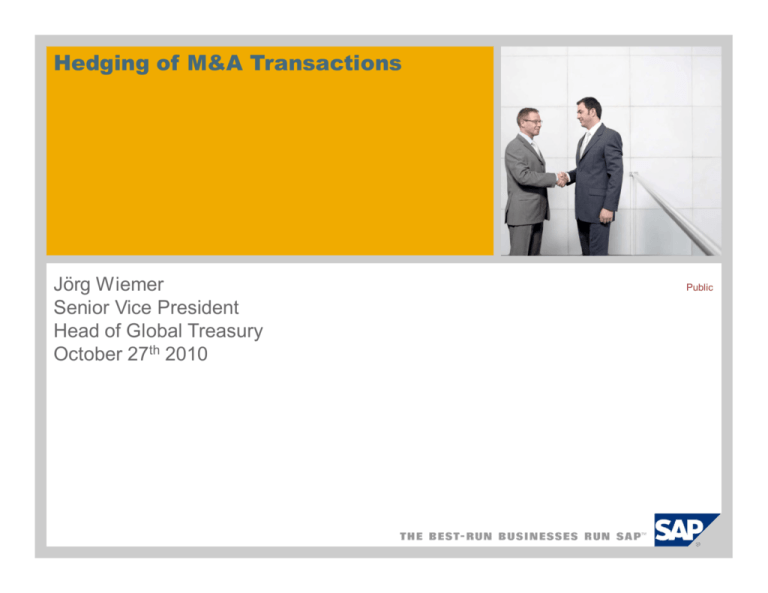
Hedging of M&A Transactions
Jörg Wiemer
Senior Vice President
Head of Global Treasury
October 27th 2010
Public
Agenda
1. Introduction
About SAP
Sybase tender offer
2. Financial Risks in M&A Transactions
Liquidity risk
Interest rate risk, counterparty risk, settlement risk, FX risk
3. Hedging of Financial Risks in M&A Transactions
Driving forces for M&A hedging decision process
Decision matrix: Hedging instruments
© SAP AG 2010. All rights reserved. / Page 2
Public
The World’s Leading Provider of Business
Application Software
Undisputed market leader with >100,000 customers in 120 countries
– the largest customer base in enterprise applications
A solid track record of growth and return to
investors
Strong sales opportunity into installed base –
business with existing customers accounts
for ~80% of order entry
Steadily increasing share of recurring
revenues – over 50%
Recognized global brand (27th most valuable
in the world according to BusinessWeek*)
Deepest industry knowledge with more than
25 industry solutions available
Strong focus on ecosystem to foster coinnovation
Leading product and technology innovation
with ~14,500 developers
* Source: Interbrand / BusinessWeek 2009
© SAP AG 2010. All rights reserved. / Page 3
Public
SAP’s Long-Term Success – Selected KPI’s
Total Revenue
SSRS Revenue
Operating Profit
CAGR 7.7%
CAGR 10.2%
CAGR 13.9%
11.7
8.5
9.4
10.3
5.1
1999
8.6
10.7
7.4
6.0
8.2
1999
2.5
2.9
6.6
3.1
2005 2006 2007 2008 2009
2.3
2.7
3.3
0.8
2005 2006 2007 2008 2009
1999
2005 2006 2007 2008 2009
Free Cash Flow*
Operating Margin
CAGR 25.7%
27% 27% 26% 28% 27%
2.8
1.8
16%
1.3
1.5
1.5
SAP’s business model
continuously proved to be
sustainable, robust and
long-term oriented
0.3
1999
2005 2006 2007 2008 2009
1999
2005 2006 2007 2008 2009
Note: 1999 and 2005 based on US-GAAP; 2006 and 2007 based on IFRS; 2008 and 2009 based on Non-IFRS; in € billion, unless stated otherwise
* Cash flow from operations less capital expenditure
© SAP AG 2010. All rights reserved. / Page 4
Public
Sybase Tender Offer
On May 12th, 2010, SAP and Sybase Inc. signed a definitive merger agreement
SAP America, a subsidiary of SAP AG, makes an all cash tender offer for Sybase representing
an enterprise value of approximately USD 5.8bn
The transaction is funded from SAP’s cash on hand (partially USD) and a €2.75bn loan facility
Closing of tender offer is conditioned of a majority of outstanding shares (50,1%) and clearance
by the relevant antitrust authorities (both the US and Europe)
As of the expiration of the tender offer, 92,1% of Sybase’s outstanding shares of common stock
were tendered
The acquisition was immediately completed via a short-form merger under Delaware law
Rationale for this strategic move
Accelerate the reach of SAP solutions across mobile platforms to help companies managing and
analyzing business information and processes on any device
Drive forward the realization of SAP’s in-memory computing vision
© SAP AG 2010. All rights reserved. / Page 5
Public
Agenda
1. Introduction
About SAP
Sybase tender offer
2. Financial Risks in M&A Transactions
Liquidity risk
Interest rate risk, counterparty risk, settlement risk, FX risk
3. Hedging of Financial Risks in M&A Transactions
Driving forces for M&A hedging decision process
Decision matrix: Hedging instruments
© SAP AG 2010. All rights reserved. / Page 6
Public
Financial Risks in M&A Transactions (1/2)
Liquidity risk Significant appreciation of USD against EUR will create additional liquidity
needs measured in EUR
Actions taken Loan facility was established before final decision from supervisory board was
made and merger agreement was signed. In addition to available cash this guaranteed
minimum requirement of strategic liquidity level
Example: Potential cash outflow for
USD 5.8bn acquisition
7.500
6.500
5.500
4.500
3.500
2.500
1.500
500
-500
-1.500
-2.500
SAP Group
Gross Liquidity in
€m
Gross Liquidity
Minimal Liquidity
Credit Line
Scenario I
EUR/USD 1,30
Scenario II
EUR/USD 1,15
Scenario III
EUR/USD 1,00
€4.5bn
€5.0bn
€5.8bn
€2.75bn
loan facility
€1.5bn minimum strategic liquidity
Approx. €500m Bilateral credit lines
€1.5bn Syndicated credit line
EUR/USD ECB Fixing on May 12th: 1.2686
© SAP AG 2010. All rights reserved. / Page 7
Public
Financial Risks in M&A Transactions (2/2)
Interest rate risk Value at Risk calculation showed no significant impact for changes in 2 year
EUR swap rate in the period between beginning and closing of tender offer. Given SAP’s strong
cash flow generation a repayment of the loan facility will be possible within 2 years
Acceptance ratio Financing Volume in €m Value at Risk in €m
50%
1.375
12,50
75%
2.063
18,76
100%
2.750
25,01
50 day 99% VaR
Tender Offer risk Acceptance ratio for tender offer might be too low
Foreign exchange risk No P+L risk, only translation risk. Higher EUR counter value of future
free cash flow from Sybase to SAP compensates for “higher” purchase price if USD increases.
However, FX risk leads to liquidity risk
Acceptance ratio
50%
75%
100%
Exposure in USDm
Value at Risk in €m
2.400
293
3.850
469
5.300
646
50 day 99% VaR
An increase of the acceptance ratio by 1% leads to additional VaR of € 7m
Settlement risk Settlement of USD FX deals with different counterparties and same day value
payment to the US is a huge challenge
© SAP AG 2010. All rights reserved. / Page 8
Public
Agenda
1. Introduction
About SAP
Sybase tender offer
2. Financial Risks in M&A Transactions
Liquidity risk
Interest rate risk, counterparty risk, settlement risk, FX risk
3. Hedging of Financial Risks in M&A Transactions
Driving forces for M&A hedging decision process
Decision matrix: Hedging instruments
© SAP AG 2010. All rights reserved. / Page 9
Public
Driving Forces for M&A Hedging Decision
Process
Intercompany structure /
Internal Financing
Uncertainty about
approval of antitrust
authorities
Uncertainty about
success of tender offer /
acceptance ratio
Volatility in Capital
Markets
Hedging decision
Avoidance of P+L
volatility created via
pre-hedge
Market squeeze when
(FX) hedging activities
are started
Deal contingent hedging /
Definition of “highly
probable”
IFRS Accounting of
hedging instruments
© SAP AG 2010. All rights reserved. / Page 10
Public
Some Thoughts on Choice of Hedging
Instruments
Example 1
•
Do nothing does not create P&L volatility as a higher purchase price increases goodwill
•
However, a further depreciation of the EUR bears significant liquidity risks
Example 2
•
Plain Vanilla Forward hedges liquidity risk if the tender offer is successful
•
However, significant P+L and cash effect possible if tender offer is not successful
Example 3
• Enter into an at-the-money Plain Vanilla Option to hedge against liquidity risk
•
However, significant premium has to be paid which does not qualify for Hedge
Accounting (time-value)
© SAP AG 2010. All rights reserved. / Page 11
Public
Some Thoughts on Choice of Hedging
Instruments
Example 4
•
Deal contingent forward hedges liquidity risk at considerable cost, regardless of success
of tender offer
•
However, there is no flexibility on the acceptance ratio of the tender offer (over-hedging
might happen)
Usage of this instrument may lead to discussion with auditor on definition of “highly
probable”, which might not allow hedge accounting treatment
•
Example 5
•
Deal contingent option hedges liquidity risk regardless of success of tender offer
•
However, Hedge Accounting might not be applicable (“highly probable”) and increased
premium has to be paid in case of successful transaction
Example 6
•
Define a critical level at which liquidity risk is still acceptable
•
In case the critical level is triggered: Enter into an at-the-money Plain Vanilla Option
© SAP AG 2010. All rights reserved. / Page 12
Public
Decision matrix: Hedging Instruments
Do nothing
Plain Vanilla
Forward*
Plain Vanilla
Option atm*
Deal Contingent Deal Contingent Wait and hedge
Forward**
Option**
worst-case
Tender offer successful
Liquidity risk
Unexpected
P&L Volatility
Costs (Premium)
Tender offer not successful
Liquidity risk
Unexpected
P&L Volatility
Costs (Premium)
Summary
* Assumption: Hedge Accounting is obtained as transaction is highly probable
** Assumption: Hedge Accounting is not obtained as transaction is not highly probable
© SAP AG 2010. All rights reserved. / Page 13
Public
Thank you!
© SAP AG 2010. All rights reserved. / Page 14
Public
Q&A
© SAP AG 2010. All rights reserved. / Page 15
Public
© Copyright 2010 SAP AG
All Rights Reserved
No part of this publication may be reproduced or transmitted in any form or for any purpose without the express permission of SAP AG. The information contained herein
may be changed without prior notice.
Some software products marketed by SAP AG and its distributors contain proprietary software components of other software vendors.
Microsoft, Windows, Excel, Outlook, and PowerPoint are registered trademarks of Microsoft Corporation.
IBM, DB2, DB2 Universal Database, System i, System i5, System p, System p5, System x, System z, System z10, System z9, z10, z9, iSeries, pSeries, xSeries, zSeries,
eServer, z/VM, z/OS, i5/OS, S/390, OS/390, OS/400, AS/400, S/390 Parallel Enterprise Server, PowerVM, Power Architecture, POWER6+, POWER6, POWER5+,
POWER5, POWER, OpenPower, PowerPC, BatchPipes, BladeCenter, System Storage, GPFS, HACMP, RETAIN, DB2 Connect, RACF, Redbooks, OS/2, Parallel Sysplex,
MVS/ESA, AIX, Intelligent Miner, WebSphere, Netfinity, Tivoli and Informix are trademarks or registered trademarks of IBM Corporation.
Linux is the registered trademark of Linus Torvalds in the U.S. and other countries.
Adobe, the Adobe logo, Acrobat, PostScript, and Reader are either trademarks or registered trademarks of Adobe Systems Incorporated in the United States and/or other
countries.
Oracle is a registered trademark of Oracle Corporation.
UNIX, X/Open, OSF/1, and Motif are registered trademarks of the Open Group.
Citrix, ICA, Program Neighborhood, MetaFrame, WinFrame, VideoFrame, and MultiWin are trademarks or registered trademarks of Citrix Systems, Inc.
HTML, XML, XHTML and W3C are trademarks or registered trademarks of W3C®, World Wide Web Consortium, Massachusetts Institute of Technology.
Java is a registered trademark of Sun Microsystems, Inc.
JavaScript is a registered trademark of Sun Microsystems, Inc., used under license for technology invented and implemented by Netscape.
SAP, R/3, SAP NetWeaver, Duet, PartnerEdge, ByDesign, SAP Business ByDesign, and other SAP products and services mentioned herein as well as their respective
logos are trademarks or registered trademarks of SAP AG in Germany and other countries.
Business Objects and the Business Objects logo, BusinessObjects, Crystal Reports, Crystal Decisions, Web Intelligence, Xcelsius, and other Business Objects products and
services mentioned herein as well as their respective logos are trademarks or registered trademarks of Business Objects S.A. in the United States and in other countries.
Business Objects is an SAP company.
All other product and service names mentioned are the trademarks of their respective companies. Data contained in this document serves informational purposes only.
National product specifications may vary.
These materials are subject to change without notice. These materials are provided by SAP AG and its affiliated companies ("SAP Group") for informational purposes only,
without representation or warranty of any kind, and SAP Group shall not be liable for errors or omissions with respect to the materials. The only warranties for SAP Group
products and services are those that are set forth in the express warranty statements accompanying such products and services, if any. Nothing herein should be construed
as constituting an additional warrant.
© SAP AG 2010. All rights reserved. / Page 16
Public



